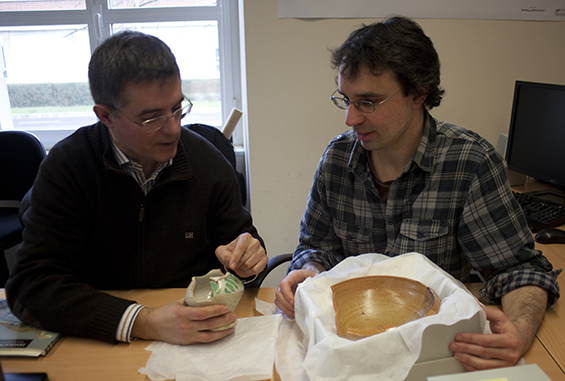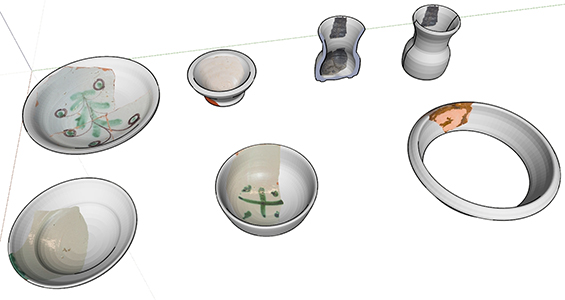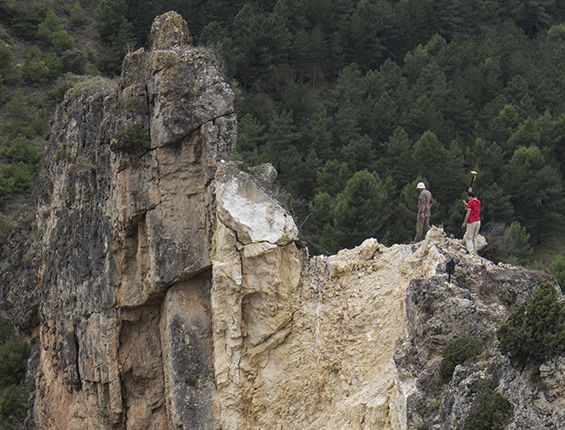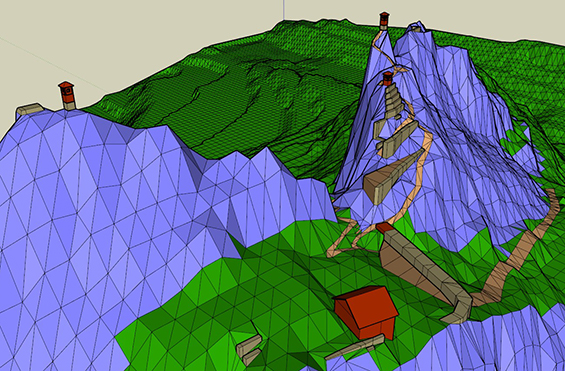
José Manuel Valle Melón and Álvaro Rodríguez Miranda are professors at the University of the Basque Country (UPV/EHU) who are part of the Geometric Documentation of Heritage Laboratory.They met us at their facility on the Vitoria-Gasteiz campus, to tell us about their mission:the geometric documentation of all kinds of heritage elements, from registering architectural remains to producing virtual reconstructions of ceramic pots from fragments.
The researchers from the Laboratory use various techniques and technologies, such as photogrammetry and 3D scanning, to create three-dimensional models of the heritage remains that they aim to preserve.After that, the applications are endless. Physical models can be created to scale using 3D printing technology, they can be viewed on a mobile device using augmented reality technology and they can be examined directly on a computer or used to capture digital images that illustrate publications.

Their models are used in different fields. In research, they can be used to preserve the geometric information about an archaeological site before work starts, so that a record is made before the changes that may occur due to any such activities. In restoration, they are used to make decisions about the direction of the work or to keep a pre-restoration model.Furthermore, more visual technologies such as printed physical models or augmented reality through mobile devices have numerous dissemination applications.Finally, some of their work is used in teaching for a variety of degrees, and even in high schools.
“We make everything that we do available to the public”
“We make virtually everything that we do available to the public on our website,” explained José Manuel, “we believe that, as educators, it is our duty to disseminate our work”.They carried out their first projects in 1996 and, since then, the number of projects published on both the website and on the Basque Country University’s ADDI repository has kept on growing.
Although the techniques that they deploy could have applications in many other fields, the Laboratory focuses solely on preserving heritage.They see it as a duty of public service and their extensive range of services is fully geared towards applications in heritage.

The Laboratory is currently working on a number of projects.One of them, working in conjunction with the researcher Ikerbasque Javier García Iñañez, consists of the 3D modelling of several ceramic remains from the 16th-18th centuries. In addition to recording the tiniest of details about the available fragments, they virtually reconstruct the shape of the complete piece, to enable them to view and make sense of the fragment.
Another project consists of the geometric reconstruction of the remains of an ancient fortress that was on the Conchas de Haro.The Laboratory’s researchers have combined the information from the official maps with a detailed model of the wall and surrounding areas.Additionally, with the help of the project’s archaeologist, they are trying to visualise the appearance of the fortress, determine which areas offered visibility and what its function could have been.To do this, with the few remains available, they are trying to show where the walls and watchtowers could have been located.

When we ask them what value they place on these knowledge transfer activities, they tell us that there are many benefits.“Many of the projects that we carry out end up being used for teaching,” explained José Manuel.“Also, it means that we have to keep up-to-date with the latest technology,” added Álvaro, “in many cases we have even had to develop our own technology, which didn't exist at the start of the project but which the market later improved.” And that is without counting the number of final year projects and master's degree final projects that they have directed.Over the years, many students have had the chance to develop a project under the guidance of the members of the Laboratory.Finally, external projects are also "a source of funding which allows us to acquire specialised equipment or hire it for specific studies”, explained José Manuel.
The “Synagogue” Mausoleum of Sádaba
So that you can see the type of work that they do, we asked them to show us one of their projects: the “Synagogue” Mausoleum of Sádaba (Zaragoza). This is a small building with a cross-shaped floor that is 12 by 14 metres, whose remains reach a maximum height of 4 metres.It is currently believed that it may be a mausoleum from Roman times. Here is a chance to view it directly on your computer:
The roman mausoleum so-called “the Synagogue” by LDGP Geometric Documentation of Heritage Lab. on Sketchfab
You can also try an augmented reality version.To do this, you need a mobile device with Android and a printer.You have to follow these steps:
Do you need an expert? Contact us
What is the benefit of contracting projects with companies?
¿Cómo puedo contratar proyectos con la Universidad?
Euskoiker has more than 30 years of experience managing all kinds of projects